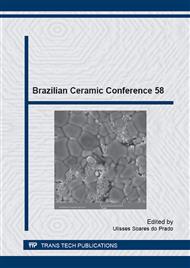p.143
p.149
p.155
p.161
p.167
p.172
p.181
p.187
p.193
Pure and La3+/Nd3+ Doped SrTiO3 Powders Obtained by Solid State Reaction and Microwave Assisted Hydrothermal Synthesis
Abstract:
Strontium titanate ceramic powders (SrTiO3), pure and doped with lanthanum (La3+) and neodymium (Nd3+), were synthesized by solid state reaction (SSR) and microwave assisted hydrothermal technique (MHT). For SSR, a mixture of SrCO3, TiO2, La2O3 and Nd2O3 oxides was performed in stoichiometric ratio, to produce SrTiO3 (STO), Sr0.96La0.04TiO3 (STO-04La), Sr0.96Nd0.04TiO3 (STO - 04Nd) and Sr0.96La0.02Nd0.02TiO3 (STO-02La02Nd), in a ball mill, for 3.5 h. This mixture was dried at 70°C for 24h. This powder was calcined at 1150°C for 2h in a conventional oven. For MHT synthesis, Ti (C4H9O)4, SrCO3, La2O3 and Nd2O3 precursors were solubilized in nitric acid (10M), in stoichiometric proportions to form STO , STO-04La, STO-04Nd and STO-02La02Nd. This solution was precipitated adding NH4OH (10M). Quota of 2g of precipitated powder was then dried in an air oven at 70°C for 24 hours, and then added to 40 ml of a KOH solution (10M). These suspensions were subjected to MHT for 1h, at 120°C. The ceramic powders obtained by the two routes were characterized by scanning electron microscopy (SEM) and X-ray diffraction (XRD). The crystallite size was calculated by Scherrer method and from SEM image, linear intercept method for both the SSR and MHT powders was used to measure the particles size, which show the increase of particles size related to the cation substitution.
Info:
Periodical:
Pages:
167-171
Citation:
Online since:
June 2015
Keywords:
Price:
Сopyright:
© 2015 Trans Tech Publications Ltd. All Rights Reserved
Share:
Citation:


